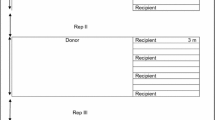Abstract
Common buckwheat is an obligate cross pollinating crop because of its sporophytic self-incompatibility system. Therefore a study to assess the extent of natural outcrossing was undertaken for two years at Morden and Portage la Prairie, Manitoba using the semi-dwarf character, which is due to a homozygous genotype with regard to a single recessive gene, as a marker. The semi-dwarf genotype was grown in 100 m rows running in four directions at 90 ° from a central 36 m2 plot of a normal, tall variety. At maturity, seed samples were taken from the semi-dwarf population at designated intervals. At least 200 F1 seeds from each sample were grown in the greenhouse to the 3-4 leaf stage and the proportion of tall plants was used to determine the percentage of outcrossing. Approximately 50% outcrossing occurred where the semi-dwarf plants were immediately next to the normal plants and then the proportion decreased with increasing distance. Although outcrossing occurred throughout the distance tested, there were no significant differences from 12 m onward from the pollen source. Lack of directional influence in outcrossing and a sharp reduction in the proportion of tall plants within a 3 m distance from the pollen source suggested that wind was not a major factor in dispersing the buckwheat pollen over long distances. Although a substantial cross pollination was limited to a few metres from the pollen source, nearly 1% outcrossing occurred even at 100 m. Since the distance in this experiment was limited to 100 m from the pollen source, the present results do not allow us to recommend the minimum isolation distance required to meet certain standards for buckwheat seed production.
Similar content being viewed by others
References
Afzal, M. & A.H. Khan, 1950. Natural crossing in cotton in Western Punjab. Agron. J. 42:202–205.
Anonymous, 1988. Regulations and procedures for pedigreed seed production. Circular 6-88. Canadian Seed Growers' Association.
Bateman, A.J., 1947. Contamination of seed crops. III. Relation with isolation distance. Heredity 1: 303–336.
Björkman, T., 1995. Role of honey bees (Hymenoptera: Apidae) in the pollination of buckwheat in eastern North America. J. Econ. Entomol. 88: 1739–1745.
Bradner, N.R., R.V. Frakes & W.P. Stephen, 1965. Effects of bee species and isolation distance on possible varietal contamination in alfalfa. Agron. J. 5: 247–248.
Campbell, C.G., 1987. Registration of CM221 semi-dwarf buckwheat germplasm. Crop Sci. 27: 151.
Datta, A.N., S.N. Maiti & S.L. Basak, 1982. Outcrossing and isolation requirement in jute (Corchorus olitorius L.). Euphytica 31: 97–101.
Frankel, R. & E. Galun, 1977. Pollination Mechanisms, Reproduction and Plant Breeding. Springer-Verlag Berlin Heidelberg.
Free, J.B., 1970. Insect pollination of crops. Academic Press, London and New York.
Free, J.B. & I.H. Williams, 1972. The transport of pollen on the body hairs of honey bees (Apis mellifera L.) and bumble bees (Bumbus spp. L.). J. Appl. Ecol. 9: 609–615.
Fryxell, P.A., 1956. Effect of varietal mass on percentage of outcrossing in Gossypium hirsutum in New Mexico. J. Heredity 47: 299–301.
Krotov, A.S., 1963. Buckwheat. Publishers of Agriculture Literatures, Journal and Posters. Moscow, Leningrad.
Levin, D.A., 1978. Pollinator behaviour and the breeding structure of plant populations. In: A.J. Richards (Ed), The Pollination of Flowers by Insects, pp. 133–150. The Linnaean Soc. London.
Marshall, H.G., 1969. Description and culture of buckwheat. Pennsylvania State Univ. Agric. Exp. Sta. Bull. 754: 1–26.
Morris, J.M.R., 1947. Genetic studies on buckwheat (Fagopyrum species. Ph.D. Thesis. The Cornell University.
Shuhua-Ren & L. Anlin, 1986. The survey of cultivated buckwheat pollen spreading distance and the relation between pollen carried by insects and yield. Proc. III Intl. Symp. on Buckwheat, Pulway, Poland. II: 10–17.
Singh, S., 1950. Behaviour studies of honey bees in gathering nectar and pollen. Cornell Univ. Agric. Exp. Station, Memoir 288.
Waser, N.M. & M.V. Price, 1983. Optimal and actual outcrossing in plants, and the nature of plant-pollinator interaction. In: C.E. Jones & R.J. Little (Eds), Handbook of Experimental Pollination Biology, pp. 341–359. Scientific and Academic Editions.
Woodell, S.R.J., 1978. Directionality in bumble bees in relation to environmental factors. In: A.J. Richards (Ed), The Pollination of Flowers by Insects, pp. 31–39. The Linnaean Soc. London.
Author information
Authors and Affiliations
Rights and permissions
About this article
Cite this article
Adhikari, K., Campbell, C. Natural outcrossing in common buckwheat. Euphytica 102, 233–237 (1998). https://doi.org/10.1023/A:1018365210463
Issue Date:
DOI: https://doi.org/10.1023/A:1018365210463




